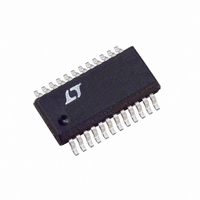LTC1406IGN#TR Linear Technology, LTC1406IGN#TR Datasheet - Page 8

LTC1406IGN#TR
Manufacturer Part Number
LTC1406IGN#TR
Description
IC ADC 8BIT 20MSPS SAMPLE 24SSOP
Manufacturer
Linear Technology
Datasheet
1.LTC1406IGNPBF.pdf
(16 pages)
Specifications of LTC1406IGN#TR
Number Of Bits
8
Sampling Rate (per Second)
20M
Data Interface
Parallel
Number Of Converters
1
Power Dissipation (max)
225mW
Voltage Supply Source
Analog and Digital, Dual ±
Operating Temperature
-40°C ~ 85°C
Mounting Type
Surface Mount
Package / Case
24-SSOP (0.150", 3.90mm Width)
Lead Free Status / RoHS Status
Contains lead / RoHS non-compliant
Available stocks
Company
Part Number
Manufacturer
Quantity
Price
LTC1406
APPLICATIONS
Signal-to-Noise Ratio
The signal-to-noise plus distortion ratio [S/(N + D)] is the
ratio between the RMS amplitude of the fundamental input
frequency and the RMS amplitude of all other frequency
components at the ADC output. The output is band limited
to frequencies above DC to below half the sampling fre-
quency. The effective number of bits (ENOBs) is a mea-
surement of the resolution of an ADC and is directly related
to the S/(N + D) by the equation:
8
ENOB = [S/(N + D) – 1.76]/6.02
–100
–100
Figure 2b. Nonaveraged, 4096 Point FFT
Input Frequency = 30MHz
Figure 2a. Nonaveraged, 4096 Point FFT
Input Frequency = 1MHz
–10
–20
–30
–40
–50
–60
–70
–80
–90
–10
–20
–30
–40
–50
–60
–70
–80
–90
0
0
0
0
f
f
SFDR = 54.9dB
SINAD = 47.0dB
SAMPLE
IN1
1
1
= 28.99902MHz
U
2
2
= 20MHz
3
3
FREQUENCY (Hz)
FREQUENCY (Hz)
INFORMATION
U
4
4
5
5
f
f
SFDR = 64.8dB
SINAD = 48.6dB
SAMPLE
IN1
6
6
= 1.000977MHz
7
7
W
= 20MHz
8
8
1406 F02a
1406 F02b
9
9
10
10
U
where ENOB is the effective number of bits and S/(N + D)
is expressed in dB. At the maximum sampling rate of 20MHz
the LTC1406 maintains near ideal ENOBs up to and be-
yond the Nyquist input frequency of 10MHz (see Figure 3).
Total Harmonic Distortion
Total harmonic distortion is the ratio of the RMS sum of all
harmonics of the input signal to the fundamental itself. The
out-of-band harmonics alias into the frequency band
between DC and half the sampling frequency. THD is
expressed as:
where V
quency and V
ond through n
shown in Figure 4. The LTC1406 has good distortion per-
formance up to the Nyquist frequency and beyond.
Intermodulation Distortion
If the ADC input signal consists of more than one spectral
component, the ADC transfer function nonlinearity can
produce intermodulation distortion (IMD) in addition to
THD. IMD is the change in one sinusoidal input caused by
the presence of another sinusoidal input at a different fre-
quency (see Figure 5).
Figure 3. Effective Bits and Signal-to-(Noise + Distortion)
vs Input Frequency
THD
1
is the RMS amplitude of the fundamental fre-
20
8
7
6
5
4
3
2
1
0
100k
2
log
th
through V
harmonics. THD vs Input Frequency is
V
INPUT FREQUENCY (Hz)
2
2
1M
V
n
3
2
are the amplitudes of the sec-
V
1
V
10M
4
2
. . .V
1406 TA02
n
2
100M
50
44
38
32













